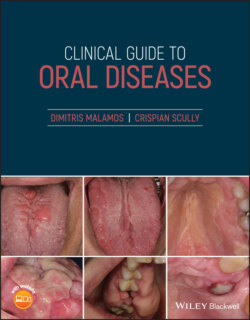Читать книгу Clinical Guide to Oral Diseases - Crispian Scully - Страница 46
Case 3.10
ОглавлениеFigure 3.10a
Figure 3.10b
CO: A 22‐year‐old student was evaluated for a brown discoloration of his tongue.
HPC: The tongue became brown after a course of antibiotics for pericoronitis on his lower left wisdom tooth two weeks ago.
PMH: His medical history is clear from any serious diseases except for a few episodes of aphthous stomatitis, two to three times a year. He is not on any medicines apart from antibiotics and chlorhexidine mouthwash recently. He is a chronic smoker of 10 to 15 cigars per day and chews mint flavor chewing gum on a regular basis.
OE: The oral examination revealed a brown discoloration on his dorsum of his tongue (Figure 3.10a) associated with hypertrophy of filiform papillae (Figure 3.10b).This discoloration covered the middle of the area, but was more prominent on the posterior part of the tongue and was related to mild halitosis. This discoloration was partially wiped off by scrubbing his tongue with a wooden spatula, and it had no other connection with similar lesions on the oral and other mucosae.
Q1 What is the cause?
1 Pseudomembranous candidiasis
2 Brown hairy tongue
3 Hairy leukoplakia
4 Mint‐induced stomatitis
5 Smoking melanosis
Answers:
1 No
2 No
3 Brown hairy tongue is a variation of hairy tongue and is presented with an abnormal keratin coating of the elongated filiform papillae on the dorsum of the tongue. It is commonly found among young anxious patients with poor oral hygiene, who smoke, take antibiotics – metronidazole in particular – or use strong mouthwashes on a regular basis, as in the case of this young man.
4 No
5 No
Comments: The lesions in pseudomembranous candidiasis are white creamy lesions that are spread all over the oral mucosa apart from the tongue, and can be easily removed with a spatula, leaving only an erythema underneath. Hairy leukoplakia lesions appear as white fixed lesions on the lateral margins and not on the dorsum of tongue in immuno‐compromised patients, while the mint induced stomatitis lesions are not only restricted to the area of tongue (lateral margins) but can be also be seen in other parts that are exposed to mint flavor. Cigar smoking may contribute to the brown discoloration through the accumulation of nicotine stains within filiform papillae in hairy tongue, but also by stimulating the gingival melanocytes to produce melanin, therefore causing a gingival melanosis.
Q2 The diagnosis of this lesion is based mainly on:
1 Intra‐oral examination
2 History
3 Culture
4 Biopsy
5 Allergic tests
Answers:
1 Intra‐oral examination shows the brown covering of the dorsum of tongue.
2 History of drug/smoking or drinking habits allows clinicians to identify the possible risk factors of hairy tongue.
3 No
4 No
5 No
Comments: Although cultures and biopsies show the presence of various chromogenic bacteria and Candida species within the elongated filiform papillae in hairy tongue lesions, these techniques are not widely used for diagnosis as they are expensive, time consuming and their results do not seem to alter the clinical course of this disease.
Q3 What symptom is/or are commonly associated with brown hairy tongue?
1 Pruritus
2 Metallic taste
3 Belching
4 Fatigue
5 Nausea
Answers:
1 No
2 Metallic taste is a common complaint of patients with hairy tongue as it is induced by the alteration of gustatory papillae (proliferation or delayed apoptosis) as a result of the excessive smoking, drinking, or use of strong mouthwashes.
3 No
4 No
5 No
Comments: The excessive tongue coating sometimes causes a local irritation on the palate that provokes nausea, belching, or even pruritus, especially in anxious patients.
